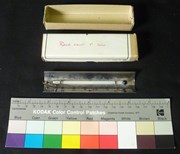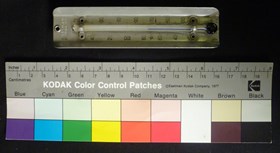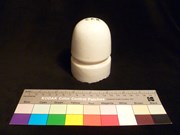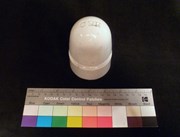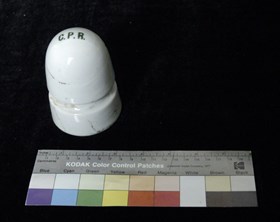Narrow Results By
Darkroom Thermometer
https://archives.whyte.org/en/permalink/artifact104.41.1163
- Date
- n.d.
- Material
- glass; mercury; metal; fibre
- Catalogue Number
- 104.41.1163
- Description
- Kodak darkroom thermometer without case. The scale only indicates Fahrenheit readings. A star is present indicating that 68°F is the ideal temperature for use in a darkroom setting. On the rear of the thermometer a series of manufacturer information is present: ”TRADE MARK REG. U.S. PAT. OFF.” ”KOD…
1 image
- Title
- Darkroom Thermometer
- Date
- n.d.
- Material
- glass; mercury; metal; fibre
- Dimensions
- 0.3 x 1.1 x 14.5 cm
- Description
- Kodak darkroom thermometer without case. The scale only indicates Fahrenheit readings. A star is present indicating that 68°F is the ideal temperature for use in a darkroom setting. On the rear of the thermometer a series of manufacturer information is present: ”TRADE MARK REG. U.S. PAT. OFF.” ”KODAK DARKROOM THERMOMETER” and “MADE IN U.S.A. FOR EASTMAN KODAK COMPANY ROCHESTER, N.Y.”
- Subject
- photography
- darkroom
- Nick Morant
- Credit
- Gift of Nicholas Morant, Banff, 2006
- Catalogue Number
- 104.41.1163
Images
This material is presented as originally created; it may contain outdated cultural descriptions and
potentially offensive content.
Read more.
Darkroom Thermometer
https://archives.whyte.org/en/permalink/artifact104.41.1164%20a-c
- Date
- n.d.
- Material
- metal; glass; mercury; paper
- Catalogue Number
- 104.41.1164 a-c
- Description
- (a) A stainless steel metal darkroom thermometer with case. The thermometer measures only Fahrenheit with scale readings in black. The scale shows values from 20 to 120°F in 20° increments. A star and arrow is present indicating the 68°F mark, which is the ideal temperature for use in a darkroom se…
1 image
- Title
- Darkroom Thermometer
- Date
- n.d.
- Material
- metal; glass; mercury; paper
- Dimensions
- (a) 0.3; (b) 1.8; (c) 2.1 x (a) 3.5; (b) 3.5; (c) 2.8 x (a) 11.9; (b) 13.0; (c) 12.5 cm
- Description
- (a) A stainless steel metal darkroom thermometer with case. The thermometer measures only Fahrenheit with scale readings in black. The scale shows values from 20 to 120°F in 20° increments. A star and arrow is present indicating the 68°F mark, which is the ideal temperature for use in a darkroom setting. The bottom of the thermometer reads “STAINLESS STEEL” “JAPAN.”At the top there is a hook that would have allowed the thermometer to be hung from the developing tray to ensure an accurate reading before immersing negatives. (b) The object also has been safeguarded in a box. The lid of the box has a Canadian Pacific sticker adhered. Written in pink pen ink is “Read about 1° low.” The box has been fastened together using staples. (c) The bottom of the box does not contain any information. Once again there are staples present highlighting how it would have been constructed. Made in Japan.
- Subject
- photography
- darkroom
- Nick Morant
- Credit
- Gift of Nicholas Morant, Banff, 2006
- Catalogue Number
- 104.41.1164 a-c
Images
This material is presented as originally created; it may contain outdated cultural descriptions and
potentially offensive content.
Read more.
Darkroom Thermometer
https://archives.whyte.org/en/permalink/artifact104.41.1165%20
- Date
- n.d.
- Material
- metal; glass; mercury
- Catalogue Number
- 104.41.1165
- Description
- Kodak darkroom thermometer with case. The scale only indicates Fahrenheit readings beginning at 30°F and going up to 100°F increasing in 10° increments. A star and arrow is present indicating the 68°F is the ideal temperature for use in a darkroom setting. At the top of the thermometer ”EASTMAN KOD…
1 image
- Title
- Darkroom Thermometer
- Date
- n.d.
- Material
- metal; glass; mercury
- Dimensions
- 0.4 x 3.0 x 12.5 cm
- Description
- Kodak darkroom thermometer with case. The scale only indicates Fahrenheit readings beginning at 30°F and going up to 100°F increasing in 10° increments. A star and arrow is present indicating the 68°F is the ideal temperature for use in a darkroom setting. At the top of the thermometer ”EASTMAN KODAK CO.” has been imprinted; below “MADE IN U.S.A.” A clip is present on the back which would have allowed the thermometer to be hung from the developing tray to ensure an accurate reading before immersing negatives.
- Subject
- photography
- darkroom
- Nick Morant
- Credit
- Gift of Nicholas Morant, Banff, 2006
- Catalogue Number
- 104.41.1165
Images
This material is presented as originally created; it may contain outdated cultural descriptions and
potentially offensive content.
Read more.
- Date
- N/A – N/A
- Material
- ceramic
- Catalogue Number
- 104.42.1006
- Description
- Telegraph insulators with a clear glaze on a white ceramic body with the CPR (Canadian Pacific Railway) monogram. This object would have been used along the Canadian railway. The insulators have been threaded and are designed to sit loosely upon a wooden pin. This style of insulator was a later, mo…
1 image
- Title
- Insulator
- Date
- N/A – N/A
- Material
- ceramic
- Dimensions
- 10.0 cm
- Description
- Telegraph insulators with a clear glaze on a white ceramic body with the CPR (Canadian Pacific Railway) monogram. This object would have been used along the Canadian railway. The insulators have been threaded and are designed to sit loosely upon a wooden pin. This style of insulator was a later, more modern version, manufactured in a beehive shape with a threaded interior cavity, which was then turned securely onto a matching threaded wooden pin. This allowed the insulators to remain securely in place so that they wouldn’t pop free staying locked into their wooden pins. The insulator has “C.P.R.” monogram has been stamped/printed in black ink on the tip of the body, which would have faced upwards when screwed into the wooden pin. Around the circumference of the body there is slot or groove formed into the insulator where the wire would have been wrapped around the groove.
- Subject
- telegraph
- CPR
- Nick Morant
- Credit
- Gift of Nicholas Morant, Banff, 2006
- Catalogue Number
- 104.42.1006
Images
This material is presented as originally created; it may contain outdated cultural descriptions and
potentially offensive content.
Read more.
- Date
- N/A – N/A
- Material
- ceramic
- Catalogue Number
- 104.42.1007
- Description
- Telegraph insulators with a clear glaze on a white porcelain body with the CPR (Canadian Pacific Railway) monogram. This object would have been used along the Canadian railway. The insulators have been threaded and are designed to sit loosely upon a wooden pin. This style of insulator was a later, …
1 image
- Title
- Insulator
- Date
- N/A – N/A
- Material
- ceramic
- Dimensions
- 10.0 cm
- Description
- Telegraph insulators with a clear glaze on a white porcelain body with the CPR (Canadian Pacific Railway) monogram. This object would have been used along the Canadian railway. The insulators have been threaded and are designed to sit loosely upon a wooden pin. This style of insulator was a later, more modern version, manufactured in a beehive shape with a threaded interior cavity, which was then turned securely onto a matching threaded wooden pin. This allowed the insulators to remain securely in place so that they wouldn’t pop free staying locked into their wooden pins. The insulator has the “CPR” monogram has been imprinted on the tip of the body. Around the circumference of the body there is slot or groove formed into the insulator where the wire would have been wrapped around the groove.
- Subject
- telegraph
- CPR
- Nick Morant
- Credit
- Gift of Nicholas Morant, Banff, 2006
- Catalogue Number
- 104.42.1007
Images
This material is presented as originally created; it may contain outdated cultural descriptions and
potentially offensive content.
Read more.
- Date
- N/A – N/A
- Material
- ceramic; wood
- Catalogue Number
- 104.42.1008 a-b
- Description
- (a) Telegraph insulators with a clear glaze on a white ceramic body with the CPR (Canadian Pacific Railway) monogram. The wooden pin is present with the object. This object would have been used along the Canadian railway. The insulators have been threaded and are designed to sit loosely upon a wood…
1 image
- Title
- Insulator
- Date
- N/A – N/A
- Material
- ceramic; wood
- Dimensions
- (a) 10.0; (b) 4.7 x (b) 3.6 x (b) 29.5 cm
- Description
- (a) Telegraph insulators with a clear glaze on a white ceramic body with the CPR (Canadian Pacific Railway) monogram. The wooden pin is present with the object. This object would have been used along the Canadian railway. The insulators have been threaded and are designed to sit loosely upon a wooden pin. This style of insulator was a later, more modern version, manufactured in a beehive shape with a threaded interior cavity, which was then turned securely onto a matching threaded wooden pin. This allowed the insulators to remain securely in place so that they wouldn’t pop free staying locked into their wooden pins. The insulator has “C.P.R.” monogram has been stamped/printed in black ink on the tip of the body. Around the circumference of the body there is slot or groove formed into the insulator where the wire would have been wrapped around the groove. (b) The wooden base, acting as a pin, has two holes through the body to adhere it to the posts. The wood base also has screw threads cut into the body so that it can be affixed to the ceramic insulator. The size of the wooden pin would have depended greatly on the voltage to be isolated and the weight of the span of wire to be supported.
- Subject
- telegraph
- CPR
- Nick Morant
- Credit
- Gift of Nicholas Morant, Banff, 2006
- Catalogue Number
- 104.42.1008 a-b
Images
This material is presented as originally created; it may contain outdated cultural descriptions and
potentially offensive content.
Read more.




